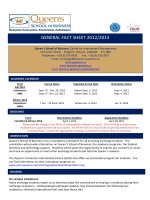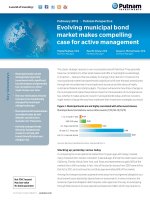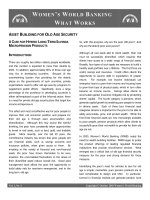FinQuiz smart summary,the case for international diversification
Bạn đang xem bản rút gọn của tài liệu. Xem và tải ngay bản đầy đủ của tài liệu tại đây (510.75 KB, 3 trang )
2013, Study Session # 8, Reading # 22
“THE CASE FOR INTERNATIONAL DIVERSIFICATION”
EM = Emerging Markets
EF = Efficient Frontier
1. THE TRADITIONAL CASE FOR INTERNATIONAL DIVERSIFICATION
Two motivations for global investment:
Reduction of the volatility.
Profitable opportunities.
Addition of more risky foreign assets to a purely domestic portfolio will reduces its
total risk (correlations is not large).
When a portfolio is partly invested in domestic assets & partly in foreign assets:
ܧ൫ܴ ൯ = ݓௗ ܧሺܴௗ ሻ + ݓ ܧ൫ܴ ൯
ߪଶ = ݓௗଶ ߪௗଶ + ݓଶ ߪଶ + ݓௗ ݓ ݒܥௗ,
ߪ = ටߪଶ
ݒܥௗ, = ߩௗ, ߪௗ ߪ
The correlation, the risk reduction.
Currency considerations:
ܴ$ = ܴ + ܵ + ሺܴ ሻሺܵሻ
where
ܴ$ = Return of foreign asset in U.S $ term.
ܴ = Return of foreign asset in local currency.
S = % ∆ in the foreign currency.
Third term captures the fact that currency appreciation captures original capital as
well as capital gains.
ଶ
ߪ$ଶ = ߪ
+ ߪௌଶ + 2ߪ ߪௌ ߩ,ௌ
Global EF is to the left of the domestic EF ( return opportunities & risk
diversification).
On avg the common variance b/w The U.S. & other markets is < 50%.
Canadian $ bonds are most strongly correlated with U.S. $ bonds.
Correlation of U.S. bonds with every foreign bond market is <50.
Global investing should the Sharpe ratio.
Passive global diversification is wise in terms of risk but doesn’t provide a free lunch
in terms of return.
Currency Risk Not a Barriers to International Investment
Currency risk is smaller (larger) than the Risk of corresponding stock (bond) market.
Currency risk is not a significant barrier to international investment because:
Market & currency risks are no additive.
Exchange risk can be hedged through derivatives.
Part of currency risk gets diversified away by the mix of currencies
represented in the portfolio.
Contribution of currency risk with the length of investment horizon.
Copyright © FinQuiz.com. All rights reserved.
1
2013, Study Session # 8, Reading # 22
2. THE CASE AGAINST INTERNATIONAL DIVERSIFICATION
Changing correlations among international economies can have very undesirable
effects (e.g. overstating benefits of international diversification).
Correlations have been over time because:
Free trade among nations has .
Integrated capital markets.
Foreign operations by corporations.
Mobility of capital has with institutional investors.
Correlations b/w markets appear to when volatility in international markets.
Statistical aberration ⇒ the problem with estimating correlation during periods of
rising volatility is that the calculated correlation will be biased upward when in
reality it has not changed.
Barriers to International Investments
International investment is far less from what it should be because of the following
reasons.
Lack of familiarity with foreign markets.
Political risk.
Lack of market efficiency.
Lack of liquidity.
Timely & reliable information.
Price manipulation & insider trading.
Regulation.
Higher transaction cost.
Brokerage commission.
Price impact of trade
Custody cost.
Management fees.
Taxes.
Currency risk.
3. THE CASE FOR INTERNATIONAL DIVERSIFICATION REVISITED
The conclusion that correlation increases in periods of crises seems to be simply a
statistical bias due to faulty econometrics.
An enlarged investment opportunities set offers additional international
diversification benefits.
Traditionally, investors were diversifying across country factors:
First decide on a country allocation.
Second, select securities within countries.
Today, nationality of a firm has become fuzzy & companies compete in global
industries.
Although industry factors have become more important & country factors less
important, an investor should not assume that diversifying across border is no
longer required.
This cross- country, cross industry approach, is required to capture the full risk
& benefits of international diversification.
Copyright © FinQuiz.com. All rights reserved.
2
3
2013, Study Session # 8, Reading # 22
4. THE CASE FOR EMERGING MARKETS
EM offer opportunities of higher return.
Although the stand-alone risk of EM is higher but low correlation with developed
world markets offer diversification benefits.
Crises on EM tend to be larger & prolonged & international correlation tends to
in periods of crises.
In EM’s stock return & currency returns are usually +vely correlated (suffer twice in
case of a downturn).
Investability of Emerging Markets
Foreign investor may not be able to exploit attractive EM return for several reasons:
Restrictions on the amount of stock that can be held by foreigners.
Small free float.
Repatriation of invested capital is often restricted.
Discriminatory taxes.
Foreign currency restrictions.
Low liquidly.
Only authorized investors allow investment.
Segmentation v/s Integration Issue
EMs are segmented markets.
EM returns correspond more closely to local risks which results in
EMs make an attractive addition to a global portfolio ( E(R), but
is not large due to low correlations).
E(R)
in portfolio risk
Copyright © FinQuiz.com. All rights reserved.









